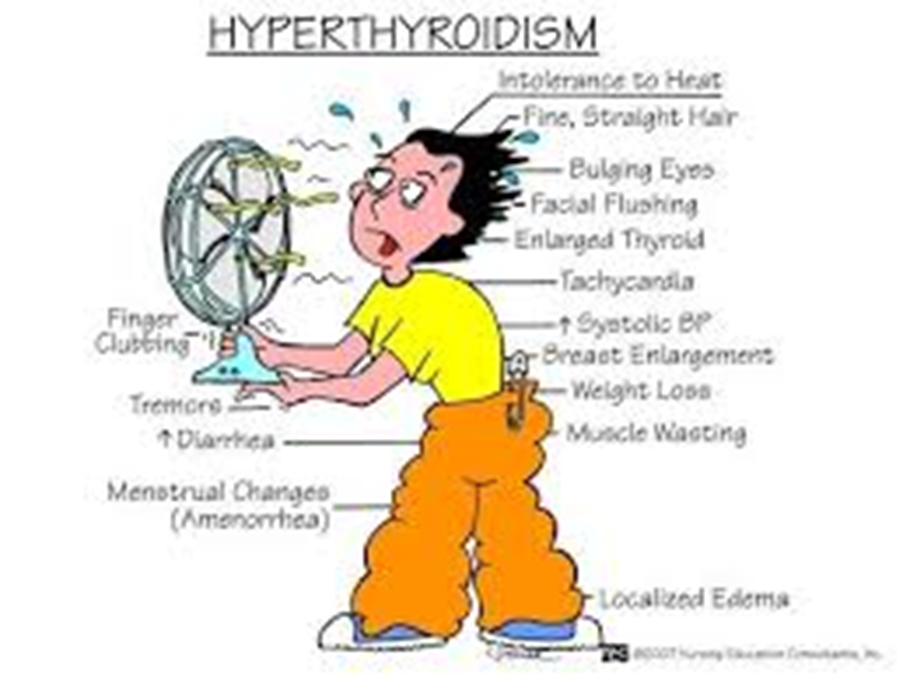A nurse is performing a physical examination on an adolescent male suspected of having an endocrine disorder. Which of the following assessment findings might be indicative of a problem with the thyroid gland?
Development of a buffalo hump and moon face
Central obesity and purple striations
Sudden weight loss without dieting
Positive Trosseau's sign when checking the client's blood pressure
The Correct Answer is C
A. Development of a buffalo hump and moon face:
This is associated with Cushing's syndrome, a disorder characterized by prolonged exposure to high levels of cortisol.
B. Central obesity and purple striations:
Also indicative of Cushing's syndrome, where excess cortisol can lead to the accumulation of fat in the abdominal area (central obesity) and the development of purple stretch marks (striae).
C. Sudden weight loss without dieting:
This is more characteristic of hyperthyroidism, where the thyroid gland is overactive, leading to increased metabolism and unintended weight loss.
D. Positive Trousseau's sign when checking the client's blood pressure:
Trousseau's sign is associated with hypocalcemia and is seen in conditions affecting the parathyroid gland rather than the thyroid. It involves carpal spasm induced by inflating a blood pressure cuff above the systolic pressure for a few minutes.

Nursing Test Bank
Naxlex Comprehensive Predictor Exams
Related Questions
Correct Answer is ["A","D","E"]
Explanation
A. I will report nausea, vomiting, or diarrhea to my primary care provider.
Correct Understanding: This is correct. Reporting these symptoms is essential because illness, especially with symptoms like nausea, vomiting, or diarrhea, can impact blood glucose levels.
B. I should avoid carbohydrates when I'm sick.
Need for Further Teaching: During illness, it's important to continue consuming carbohydrates. However, the type and amount of carbohydrates might need to be adjusted. Patients should consult their healthcare providers for guidance on managing carbohydrate intake during illness.
C. I should stop taking my insulin or oral antidiabetic agents.
Need for Further Teaching: It is not advisable to stop insulin or oral antidiabetic agents during illness. In fact, these medications often need to be continued, with potential adjustments made under the guidance of healthcare providers.
D. I will test my blood glucose and test urine ketones every 3 to 4 hours.
Correct Understanding: This is correct. Regular monitoring of blood glucose and urine ketones during illness is crucial for managing diabetes and detecting any potential complications.
E. I will continue taking my insulin or oral antidiabetic agents as usual.
Correct Understanding: This is correct. It's important to continue taking insulin or oral antidiabetic agents during illness to help manage blood glucose levels.
Correct Answer is D
Explanation
A. Respiratory acidosis:
This occurs when there is inadequate ventilation, leading to an accumulation of carbon dioxide (CO2) in the blood. In the context of a nasogastric tube attached to low suction, respiratory acidosis is not the primary concern. It is more associated with conditions like respiratory depression or lung diseases.
B. Metabolic acidosis:
Metabolic acidosis results from an excess of acid or a loss of bicarbonate. It is not the typical outcome of a nasogastric tube attached to low suction. Conditions like diarrhea or renal failure are more commonly associated with metabolic acidosis.
C. Respiratory alkalosis:
Respiratory alkalosis occurs when there is excessive loss of carbon dioxide from the body, often due to hyperventilation. This is not a typical consequence of a nasogastric tube attached to low suction.
D. Metabolic alkalosis:
Metabolic alkalosis is characterized by an excess of bicarbonate or a loss of acid. In the given context, with the nasogastric tube attached to low suction, there is a potential loss of gastric acid, contributing to metabolic alkalosis.
Whether you are a student looking to ace your exams or a practicing nurse seeking to enhance your expertise , our nursing education contents will empower you with the confidence and competence to make a difference in the lives of patients and become a respected leader in the healthcare field.
Visit Naxlex, invest in your future and unlock endless possibilities with our unparalleled nursing education contents today
Report Wrong Answer on the Current Question
Do you disagree with the answer? If yes, what is your expected answer? Explain.
Kindly be descriptive with the issue you are facing.
